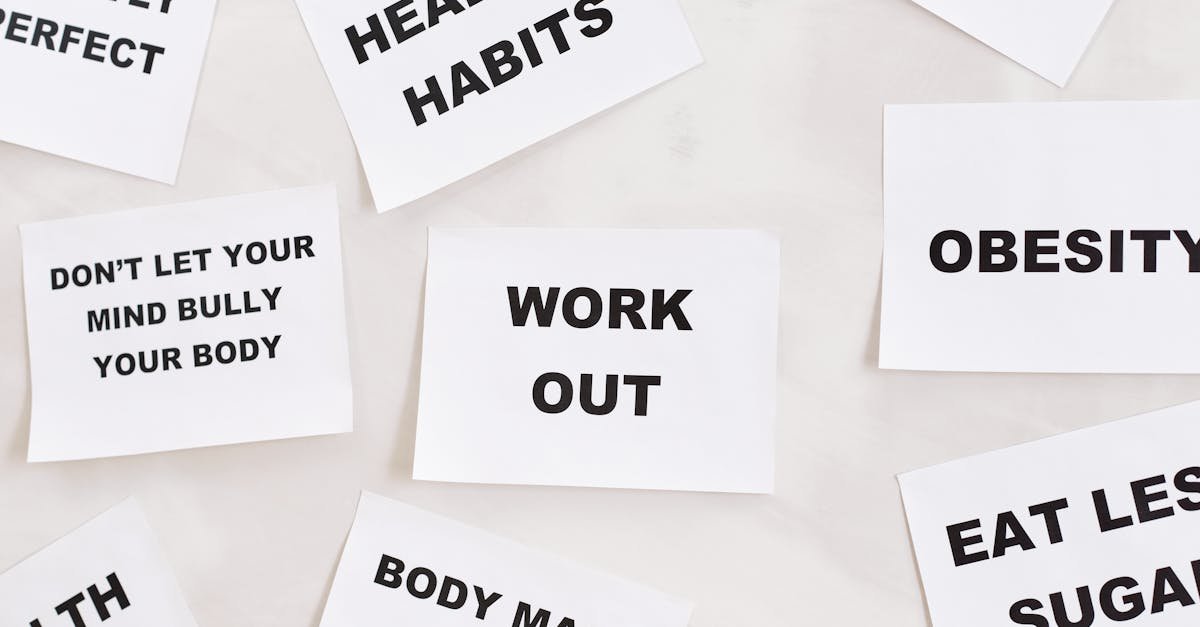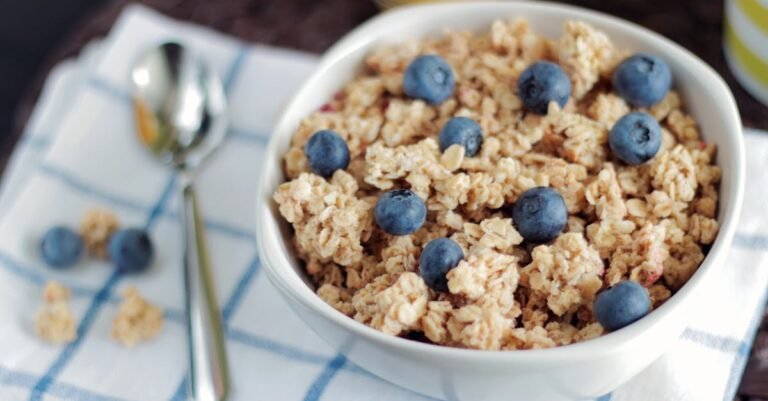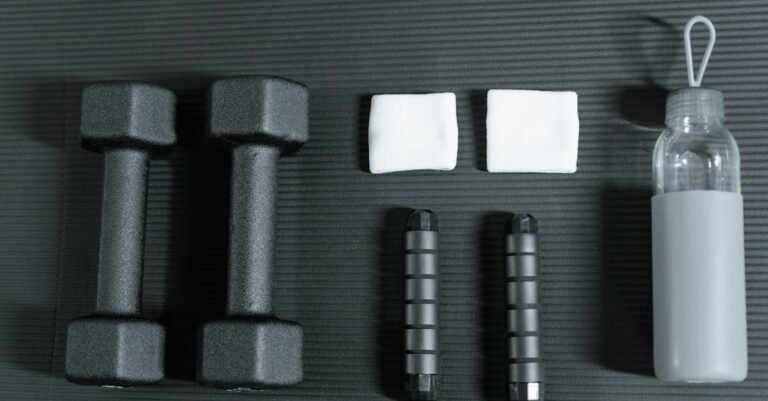Table of Content
- Healthy Habits To Support Your Fitness Goals
- Why Habits Trump Motivation Every Time
- Foundational Habit 1: Nutrition That Fuels, Not Foils
- Foundational Habit 2: Consistent Movement You Enjoy
- Foundational Habit 3: Prioritizing Sleep and Recovery
- Foundational Habit 4: Mastering Your Mindset
- Tying It All Together: Creating Your Habit Ecosystem
- Conclusion: Your Journey to a Healthier You
- Frequently Asked Questions (FAQs)
Healthy Habits To Support Your Fitness Goals
So, you’ve set some awesome fitness goals! Maybe you want to run a marathon, lift heavier weights, lose a few pounds, or simply feel more energetic throughout the day. That’s fantastic! But let’s be real: setting the goal is often the easy part. The real challenge? Sticking with it long enough to see results. That’s where the magic of healthy habits comes in. Think of your fitness goal as the destination, and healthy habits as the reliable vehicle that will actually get you there, day in and day out.
We often rely on bursts of motivation to kickstart our fitness journeys. You know, that feeling after watching an inspiring documentary or making a New Year’s resolution? While motivation is great for getting started, it’s notoriously fickle. It ebbs and flows like the tide. Habits, on the other hand, are the steady undercurrent, the automatic behaviors that keep you moving forward even when motivation dips. This article is your guide to building those powerful, goal supporting habits.
Why Habits Trump Motivation Every Time
Ever wonder why some people seem to effortlessly stay fit while others struggle? It’s usually not about superhuman willpower or endless motivation. It’s about deeply ingrained habits. Motivation might get you to the gym on Monday, but habit is what gets you there on a rainy Friday when you’d rather be on the couch.
Think about brushing your teeth. Do you need a surge of motivation to do it every morning and night? Probably not. It’s just something you do. It’s a habit. Imagine if your workouts or healthy eating choices felt that automatic! That’s the power we’re aiming to harness. Habits reduce the need for constant decision making, freeing up mental energy and making healthy choices the default, not the exception.
The Compound Effect of Small Changes
It’s tempting to go all out when starting a fitness plan – drastically changing your diet, working out for hours every day. But this ‘all or nothing’ approach often leads to burnout and quitting. The real secret lies in the compound effect of small, consistent habits. It’s like compound interest for your health!
Choosing stairs over the elevator, adding one extra serving of vegetables to your dinner, going for a 15 minute walk during your lunch break – these might seem insignificant on their own. But practiced consistently over weeks, months, and years? They add up significantly. A 1% improvement each day leads to exponential growth over time. Don’t underestimate the power of tiny, positive actions repeated daily. They build momentum and create lasting change without overwhelming you.
Building a Sustainable Fitness Lifestyle
The ultimate goal isn’t just to reach a specific fitness target; it’s to build a lifestyle that supports your health and well being long term. Diets fail. Intense, short term workout blitzes fizzle out. Habits, however, integrate fitness into the fabric of your daily life, making it sustainable.
Sustainability means finding approaches you can genuinely stick with. It’s about progress, not perfection. Some days will be better than others. You might miss a workout or indulge in a treat. A habit based approach allows for this flexibility. It’s not about being perfect; it’s about getting back on track with your next choice. Building habits focuses on the journey and the process, rather than just the end result, making fitness feel less like a chore and more like a natural part of who you are.
Foundational Habit 1: Nutrition That Fuels, Not Foils
You can’t out train a bad diet, as the saying goes. And it’s largely true! What you eat provides the energy for your workouts, the building blocks for muscle repair, and the essential nutrients for overall health. Turning healthy eating into a habit is arguably one of the most impactful things you can do for your fitness goals.
This doesn’t mean you need to eat boring, bland food or follow overly restrictive rules. It’s about making conscious choices most of the time to fuel your body properly. Think of food as information for your body. Are you giving it the right signals to perform, recover, and thrive? Let’s break down how to make nutritious eating a habit.
Understanding Macronutrients for Fitness
Getting a basic grasp of macronutrients – protein, carbohydrates, and fats – can revolutionize how you approach your meals. They each play distinct, crucial roles in supporting your fitness endeavors.
Protein Power: Building and Repairing
Protein is the superstar when it comes to muscle. When you exercise, especially resistance training, you create tiny tears in your muscle fibers. Protein provides the amino acids necessary to repair these tears and build the muscle back stronger. It’s essential not just for bodybuilders, but for anyone looking to improve strength, support recovery, and even manage weight (protein is very satiating, meaning it helps you feel full).
Habit Idea: Aim to include a source of lean protein (like chicken, fish, beans, lentils, tofu, eggs, or Greek yogurt) in every meal and snack. This ensures a steady supply for muscle repair and keeps hunger pangs at bay.
Carbs: Your Energy Source
Carbohydrates often get a bad rap, but they are your body’s preferred source of energy, especially for moderate to high intensity exercise. They break down into glucose, which fuels your muscles and brain. Cutting carbs too drastically can lead to fatigue, poor workout performance, and brain fog.
The key is choosing the *right* carbs. Focus on complex carbohydrates like whole grains (oats, brown rice, quinoa), fruits, vegetables, and legumes. These provide sustained energy release and are packed with fiber and nutrients. Simple carbs (sugary drinks, white bread, pastries) offer quick energy but often lead to a crash.
Habit Idea: Time your carb intake strategically. Consuming complex carbs a couple of hours before a workout can top up your energy stores. Having some carbs post workout helps replenish glycogen levels.
Healthy Fats: More Than Just Flavor
Fat is not the enemy! Healthy fats are crucial for hormone production (including hormones involved in muscle growth and metabolism), vitamin absorption (vitamins A, D, E, and K are fat soluble), and overall cell function. They also provide a dense source of energy, particularly important for longer duration, lower intensity activities.
Focus on unsaturated fats found in avocados, nuts, seeds, olive oil, and fatty fish (like salmon). Limit saturated fats (found in fatty meats, butter, full fat dairy) and try to avoid trans fats (often found in processed foods).
Habit Idea: Incorporate small amounts of healthy fats into your meals. A sprinkle of nuts on your oatmeal, avocado in your salad, or cooking with olive oil are easy ways to do this.
Mindful Eating: Listen to Your Body
In our fast paced world, we often eat distractedly – in front of the TV, at our desks, scrolling through our phones. Mindful eating is the practice of paying full attention to the experience of eating and drinking, both inside and outside the body. It involves noticing the colors, smells, flavors, and textures of your food, chewing slowly, and recognizing your body’s hunger and fullness cues.
This isn’t about restriction; it’s about connection. By tuning in, you become better at understanding what your body truly needs and when it’s satisfied. This can prevent overeating and help you make more nourishing choices naturally. Are you genuinely hungry, or just bored or stressed?
Habit Idea: Try eating at least one meal a day without distractions. Put away your phone, turn off the TV, sit at a table, and focus solely on your food. Notice how it tastes, how it feels, and when you start to feel comfortably full.
Hydration: The Unsung Hero
Water is involved in nearly every bodily process, including energy production, nutrient transport, temperature regulation, and joint lubrication. Even mild dehydration can significantly impair physical performance, reduce endurance, increase fatigue, and hinder recovery. Think of it like trying to run a car without enough oil – things just don’t work efficiently.
How much water do you need? It varies depending on factors like your activity level, climate, and body size. A general guideline is aiming for pale yellow urine. Don’t wait until you’re thirsty; thirst is already a sign you’re starting to get dehydrated.
Habit Idea: Carry a reusable water bottle with you throughout the day and sip consistently. Set reminders on your phone if needed. Start your day with a glass of water before anything else. Flavor your water with lemon, cucumber, or mint if you find plain water boring.
Foundational Habit 2: Consistent Movement You Enjoy
Exercise is obviously central to fitness goals, but the key habit isn’t necessarily about punishing yourself with workouts you dread. It’s about finding forms of movement you genuinely enjoy and making them a regular, non negotiable part of your routine.
Consistency beats intensity when it comes to long term results. A moderate workout done consistently three to four times a week is far more effective than an incredibly intense workout done sporadically whenever motivation strikes. Building the habit of movement is paramount.
Finding Your Fitness Groove
What’s the “best” exercise? The one you’ll actually stick with! If you hate running, forcing yourself to jog every day is a recipe for failure. If lifting weights feels intimidating or boring, don’t force it (at least initially). Explore different activities until you find something that clicks.
Could it be dancing, swimming, hiking, cycling, team sports, rock climbing, yoga, Pilates, martial arts, or even just brisk walking? There are countless ways to move your body. Experiment! Try taster classes, join local groups, or explore online tutorials. When you find activities you look forward to, integrating them into your life becomes much easier. It shifts from being a ‘should’ to a ‘want to’.
Habit Idea: Dedicate some time each week or month to trying a new physical activity. Ask friends what they enjoy. Don’t be afraid to step outside your comfort zone – you might discover a new passion!
Scheduling Your Workouts Like Appointments
“I don’t have time” is one of the most common barriers to consistent exercise. But often, it’s less about a lack of time and more about a lack of prioritization. We make time for things we deem important. Treat your workouts like crucial appointments or meetings that cannot be easily rescheduled.
Look at your weekly schedule and block out specific times for movement. Be realistic – choose times that genuinely work for you, whether it’s early morning, during lunch, or after work. Put these ‘appointments’ in your calendar or planner. Protect this time. When something else comes up, try to schedule around your workout rather than automatically canceling it.
Habit Idea: At the beginning of each week, plan out exactly when and what your workouts will be. Lay out your workout clothes the night before to remove one potential barrier in the morning.
Foundational Habit 3: Prioritizing Sleep and Recovery
You break down muscle in the gym; you build it back stronger during rest. Sleep and recovery are not optional extras; they are fundamental components of any successful fitness plan. Skimping on sleep can sabotage your efforts by impairing muscle repair, messing with hunger hormones (making you crave junk food), reducing energy levels, and increasing injury risk.
Making quality sleep and adequate recovery a habit is as crucial as your workouts and nutrition. It’s during these periods that the real magic of adaptation and improvement happens.
The Science of Sleep and Muscle Growth
During deep sleep stages, your body releases the majority of its growth hormone, a key player in repairing tissues, building muscle mass, and burning fat. Sleep also helps regulate cortisol, the stress hormone. Chronically elevated cortisol levels can hinder recovery and promote fat storage, particularly around the midsection.
Aim for 7 to 9 hours of quality sleep per night. Quality matters as much as quantity. This means creating a sleep environment and routine conducive to uninterrupted rest. Think dark, quiet, and cool.
Habit Idea: Establish a consistent sleep schedule, going to bed and waking up around the same time each day, even on weekends. Create a relaxing pre sleep routine – maybe reading a book, taking a warm bath, gentle stretching, or meditation. Avoid screens (phones, tablets, TVs) for at least an hour before bed, as the blue light can interfere with melatonin production.
Active Recovery vs. Passive Rest
Recovery isn’t just about lying on the couch (though passive rest days are important too!). Active recovery involves low intensity activities performed on rest days or after tough workouts. Think gentle walking, light cycling, swimming, foam rolling, or dynamic stretching.
Active recovery can help reduce muscle soreness (DOMS – Delayed Onset Muscle Soreness), improve blood flow to working muscles (aiding nutrient delivery and waste removal), and maintain flexibility. It keeps you moving without adding significant stress to your body.
Habit Idea: Schedule one or two active recovery sessions into your weekly routine, especially after particularly demanding workouts. Listen to your body – if you’re feeling exceptionally fatigued, a complete rest day might be more beneficial.
Foundational Habit 4: Mastering Your Mindset
Your brain is your most powerful fitness tool. The way you think about your journey, your setbacks, and your progress profoundly impacts your ability to stick with your habits and achieve your goals. Cultivating a positive, resilient, and growth oriented mindset is a habit in itself.
Fitness isn’t always linear. There will be plateaus, challenging days, and times when progress feels slow. A strong mindset helps you navigate these bumps without giving up.
Setting Realistic and SMART Goals
While we started by saying habits trump motivation for daily action, goals provide direction and purpose. However, vague goals like “get fit” or “lose weight” aren’t very helpful. Setting SMART goals makes them more actionable and trackable.
SMART stands for:
- Specific: What exactly do you want to achieve? (e.g., “Run a 5k race” instead of “get better at running”)
- Measurable: How will you track progress? (e.g., “Run 5 kilometers without stopping,” “Lose 10 pounds”)
- Achievable: Is the goal realistic given your current situation and timeframe?
- Relevant: Does this goal align with your overall values and broader health objectives?
- Time bound: When do you aim to achieve this goal? (e.g., “Run a 5k race in 3 months”)
Habit Idea: Regularly review and adjust your SMART goals. Break down larger goals into smaller, weekly or monthly mini goals to maintain focus and motivation.
Celebrating Non Scale Victories
If your goal involves weight loss, it’s easy to become fixated on the number on the scale. But progress comes in many forms! Focusing solely on weight can be discouraging, as weight can fluctuate daily due to water retention, muscle gain, and other factors.
Learn to recognize and celebrate Non Scale Victories (NSVs). These are positive changes you notice that aren’t related to your weight. Examples include:
- Having more energy
- Sleeping better
- Clothes fitting more loosely
- Feeling stronger during workouts
- Lifting heavier weights or doing more reps
- Running faster or longer
- Improved mood and reduced stress
- Clearer skin
- Feeling more confident
Habit Idea: Keep a journal where you track not only your workouts and food but also your NSVs. Acknowledge and appreciate these signs of progress – they are powerful motivators!
Tying It All Together: Creating Your Habit Ecosystem
Think of these healthy habits – nutrition, movement, sleep, mindset – not as isolated actions, but as interconnected parts of a larger ecosystem. They support and influence each other. Eating well gives you energy for workouts. Good sleep enhances recovery and workout performance. Consistent movement boosts mood and makes you more likely to make healthier food choices. A positive mindset helps you stick to your sleep schedule and nutrition plan.
Start small. Don’t try to overhaul everything at once. Pick one or two habits to focus on initially. Maybe it’s drinking more water or going for a walk three times a week. Once those feel established, add another. Use habit stacking – linking a new habit to an existing one (e.g., “After I brush my teeth in the morning, I will do 10 push ups”). Be patient and persistent. Building lasting habits takes time, but the rewards for your fitness goals and overall well being are immense.
Conclusion: Your Journey to a Healthier You
Reaching your fitness goals isn’t about finding a magic bullet or relying on fleeting bursts of motivation. It’s about the steady, consistent application of healthy habits. By focusing on fueling your body with nutritious food, moving consistently in ways you enjoy, prioritizing sleep and recovery, and cultivating a resilient mindset, you build a sustainable foundation for success. Remember the power of small changes compounding over time. Start today, choose one small habit, and begin building the healthier, fitter lifestyle you desire. It’s a journey, not a race, so be patient with yourself, celebrate your progress (especially those non scale victories!), and trust the process. You’ve got this!
Frequently Asked Questions (FAQs)
1. How long does it take to form a healthy habit for fitness?
There’s no single magic number, despite the popular “21 days” myth. Research suggests it can take anywhere from 18 to 254 days for a behavior to become automatic. The complexity of the habit (e.g., drinking a glass of water vs. going to the gym 4 times a week) and individual consistency play huge roles. Focus on consistency rather than a specific timeframe.
2. What if I miss a day or slip up on a habit?
Don’t sweat it! Missing one day doesn’t erase all your progress. The key is to get back on track with your next opportunity. Avoid the “all or nothing” mentality. If you miss a workout, aim to make the next one. If you eat something off plan, make your next meal a healthier choice. Consistency over perfection is the goal.
3. I hate exercising. How can I build a habit of movement?
Redefine “exercise.” It doesn’t have to be the gym or running if you dislike those. Focus on finding *any* physical activity you find enjoyable, or at least tolerable. Start small – even a 10 minute walk counts. Try dancing, gardening, playing with your kids or pets, hiking, swimming, or team sports. The goal is to make movement a regular part of your life, so finding something sustainable is key.
4. How important is nutrition compared to exercise for fitness goals?
Both are critically important and work synergistically. You generally can’t achieve optimal fitness results by focusing solely on one and neglecting the other. Nutrition provides the fuel and building blocks, while exercise provides the stimulus for change (muscle growth, cardiovascular improvement). For weight loss, nutrition often plays a slightly larger role initially (“you can’t outrun a bad diet”), but for overall fitness, strength, and body composition, both are essential pillars.
5. How do I stay consistent when my schedule gets crazy busy?
Prioritization and flexibility are key. Schedule workouts like important appointments. If time is tight, aim for shorter, more intense workouts or break activity into smaller chunks throughout the day (e.g., three 10 minute walks). Prepare healthy meals or snacks in advance (meal prep) to avoid grabbing unhealthy options when rushed. Remember that even small actions are better than none. Focus on maintaining the *habit*, even if the duration or intensity has to be adjusted temporarily.










